Renaissance Perugia was as violent and as full of art as was Florence. But it doesn’t occupy the same hallowed place in art history. One reason is that it is admittedly hard to compete with Donatello, Michelangelo and Botticelli. Another is that Florence (as part of the Grand Duchy of Tuscany) stayed independent, more or less, up to the Risorgimento, and its rulers kept on collecting art, while Perugia finally fell to Papal domination and suffered an inevitable decline.
And a further subtle but influential reason is that the story of Italian Renaissance art which most of us absorb, from whatever source, is essentially that first told by a bloke named Giorgio Vasari in the 16th Century. And old Giorgio, who was from Tuscany, was as parochial as any Italian. So to be admitted to membership of the pantheon he created in his seminal Lives of the Artists, it helped a lot to be Tuscan. Others tended to be damned with faint praise, even someone like Raphael, who had the poor judgement to have been born in Urbino and trained in Perugia, and who then compounded the offence by moving to Rome. And if other Italians weren’t good enough for Vasari, it’s not surprising that he understates the profound affect on Italian art of Flemish painters like Van Eyck.
Note: I had been contemplating writing this post for some time, but could not proceed because the Baglioni Chapel in Spello was closed for post-earthquake repairs for three years. The chapel reopened in late 2019 and I was able to take some photographs, but now I have the problem that a couple of the reference books I really ought to consult are in our bookcase in Umbria, and we are stuck in Australia because of the coronavirus. I might also need to revisit the Galleria Nazionale dell’Umbria in Perugia to check a couple of things. So I’ve decided to forge ahead with what I have to hand and make a few sweeping assertions from memory. When in due course I can return to Italy and check those sources, I will update this post.
Note, May 2022. I am back in Italy now, but the gallery in Perugia is closed for renovation. I have at least managed to correct the attribution of the painting about Saint Bernardino, below.
Note, August 2022. The gallery is finally open again, and much improved by the renovations.
Perugia’s most famous painter was named Pietro Vannucci, but he is so closely associated with the place that he is referred to in art history as “Perugino”, which means “the guy from Perugia”. This is cause for a certain amount of resentment to this day in the place he actually came from, a town a bit further west near the border with Tuscany, called Città della Pieve.
Perugino was a major influence on what is often referred to as “The Umbrian School” of painting, with serene-looking saints and Madonnas in pastel colours set in idyllic landscapes. While most of his surviving pieces are frescoes, he was a pioneer of the use of oil paints in Italian art. It is one of the wonderful things about Umbria that you can stop at a local parish church and see, unprotected on the wall, a work of art that, were it to be the centrepiece of an exhibition in Australia, would be behind an inch of toughened glass and cost $50 to see.

After beginning his career in Perugia – where he trained the young Raphael – Perugino worked in Florence and Rome before returning to his native Umbria. While in Florence he had a feud with Michelangelo which would have set Vasari even more against him (although the list of contemporaries with whom Michelangelo did not feud would be short). Vasari also accuses Perugino of atheism, for which there does not appear to be any other evidence.
Perugino is sometimes criticised for the uniformity of his work, and it is also true that some of his stuff, particularly the backgrounds, was probably done by his apprentices. But much of his work that survives was for local Umbrian churches. Compared to the sort of thing they might have been able to acquire before then, Perugino’s beautiful faces in beautiful landscapes, and his geometrically accurate perspective, would have been breathtakingly modern and exactly what they wanted their parishioners to see and be uplifted by. However as we shall see below, when working for a wealthy patron (and doubtless being paid accordingly) Perugino was capable of producing very individual pieces.
Now for the violence promised earlier. Even by the standards of those days, the Perugians were famously bellicose, having long-standing quarrels with many of their neighbouring towns. During the endless rivalries between the Guelphs and the Ghibellines in the Middle Ages, those towns sometimes chose the opposite of whichever faction Perugia happened to adhere to at the time, just so they could be on the other side. When Perugia switched sides, so did they, in the other direction.
It cannot be unrelated that paintings of the era, whatever religious event was being depicted, often had bands of armed men or even acts of violence occurring elsewhere in the picture. The picture below, probably by Pierantonio del Niccolò del Pocciolo, is notionally about Saint Bernardino healing a young man who had been gravely wounded in an attack. But the attack takes up much of the canvas, with the saint and his patient visible in the distance through a window.
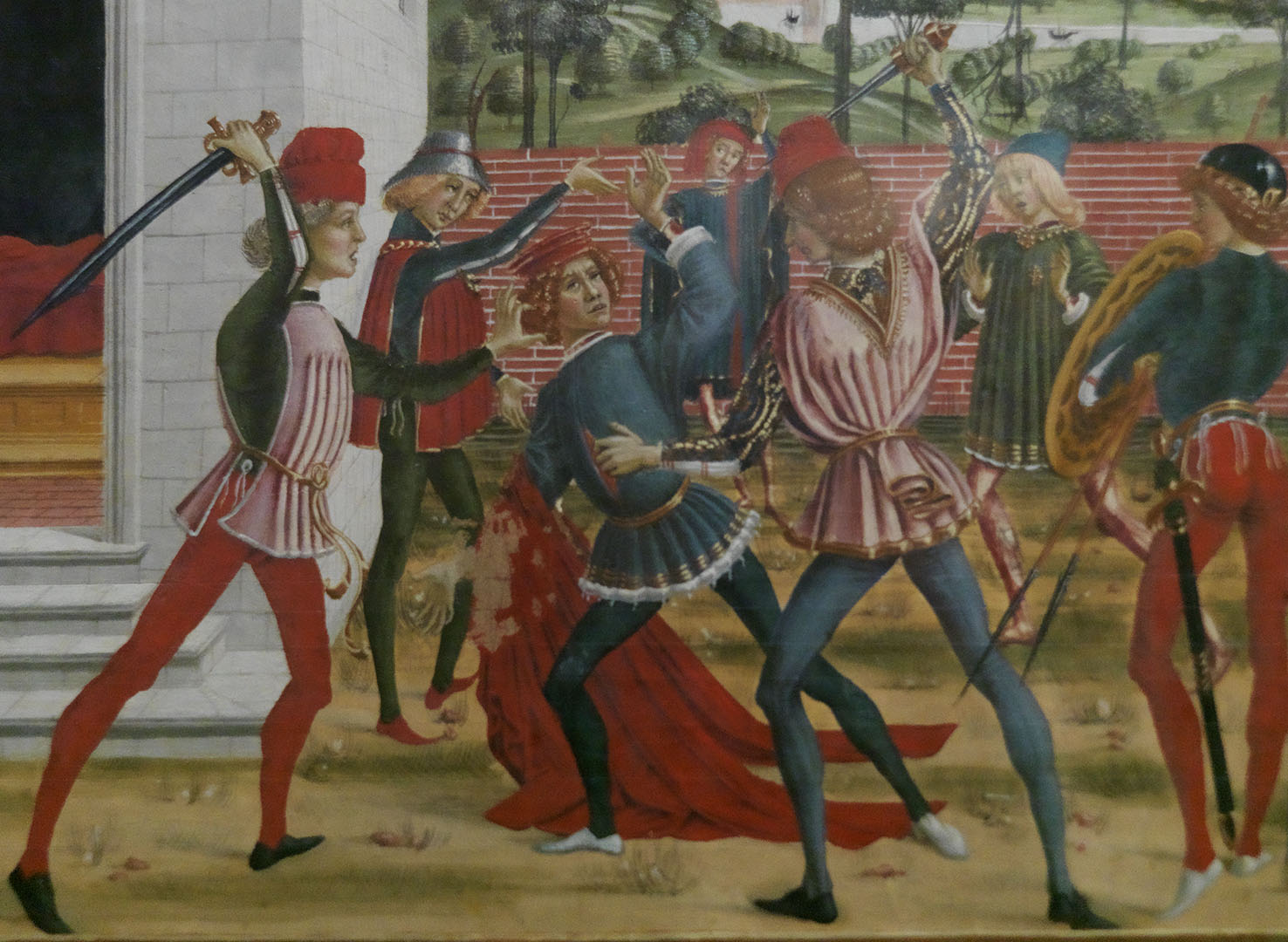
In the 15th and 16th Centuries, the dominant family in Perugia was the Baglioni, whose behaviour sounds like something out of Game of Thrones, right down to one half of the family massacring the other half at a wedding. At this point I will quote from one of my favourite books on Umbria, the result of a collaboration between an excellent writer and an outstanding landscape photographer.
“Perugia’s story during the fourteenth and fifteenth centuries is almost a parody or a pastiche of our wildest fantasies of violence and passion in Renaissance Italy… The ne plus ultra of savagery, egoism and tyranny was reached with the rise, during the early 1400s, of the Baglioni family. Everyone was afraid of them, but even the many who hated them admired their physical courage, and their beauty was a legend throughout Italy. Where they walked, crowds gathered to marvel at their handsome faces and lofty stature. Their very names – Gismondo, Astorre, Grifonetto, Atalanta, Zenobia – have the dimension of romance. Many were put to death in the appalling sequence of murders and revenges known as il gran tradimento (‘the great betrayal’) which took place in 1500, when Grifonetto tried to wipe out his entire clan and was himself killed by order of his cousin Gianpaolo.” – Jonathan Keates, Philip’s Travel Guides – Umbria, 1991, with photography by Joe Cornish, p.52.
Gianpaolo Baglioni (1470-1520) was a condottiero (mercenary captain) and Lord of Perugia who, like several nobles in the Romagna, fought for Cesare Borgia on the grounds that it was better for them to be on his side than not. When it became obvious that being on his side was no protection from his ambitions, Gianpaolo and the others changed sides. Unlike most of the others, Gianpaolo survived the experience.
If you are visiting Perugia there are a great many excellent things to see – I shall make them the subject of another post one day – but one thing that no-one should miss is the Galleria Nazionale dell’Umbria which, not surprisingly, contains some fine specimens of the Umbrian School. One large and grand painting in oils is an Adoration of the Magi, attributed to Perugino. It is known to have been commissioned by the Baglioni family, and given both that and the very individualistic depictions of the three kings and their attendants, it has been plausibly speculated that they are actual portraits of members of the Baglioni. One youthful face at the far left of the group, looking straight out at the viewer, is thought to be a self-portrait by Perugino, and it certainly looks similar to an authenticated self-portrait of an older, pudgier Perugino in the Collegio del Cambio, just down the street.
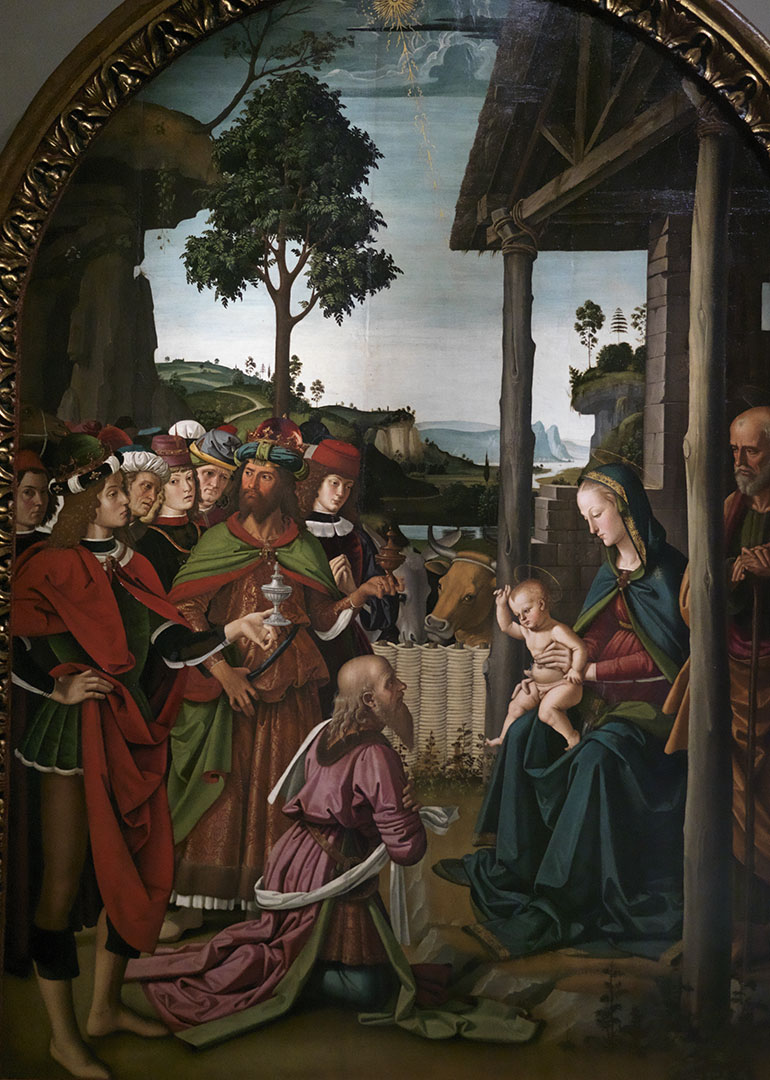
In the detail below, it certainly looks as if the principal king is someone used to giving orders, and given that no-one else in Perugia would have been doing so at the time, the idea that these are indeed members of the Baglioni family is an attractive one.
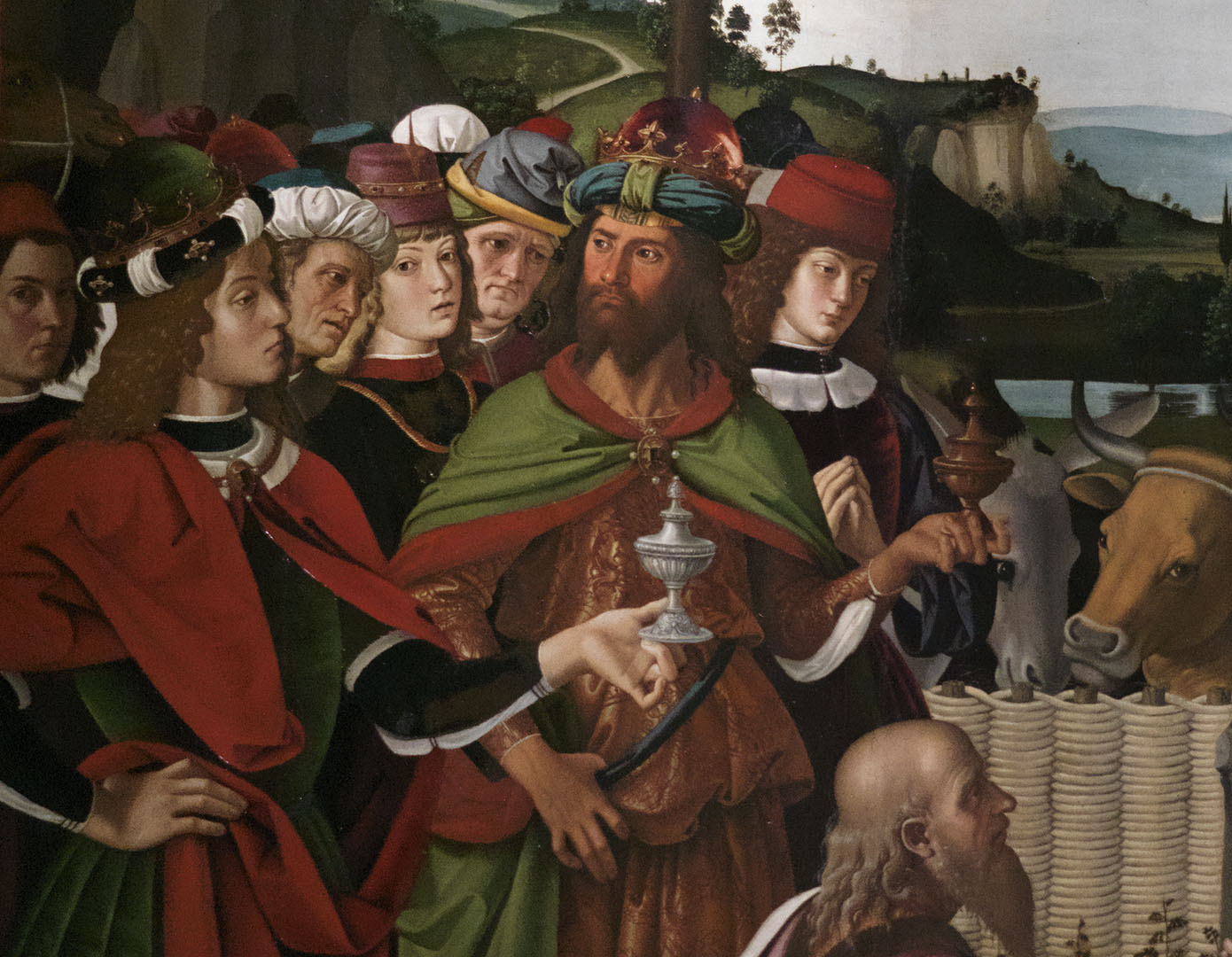
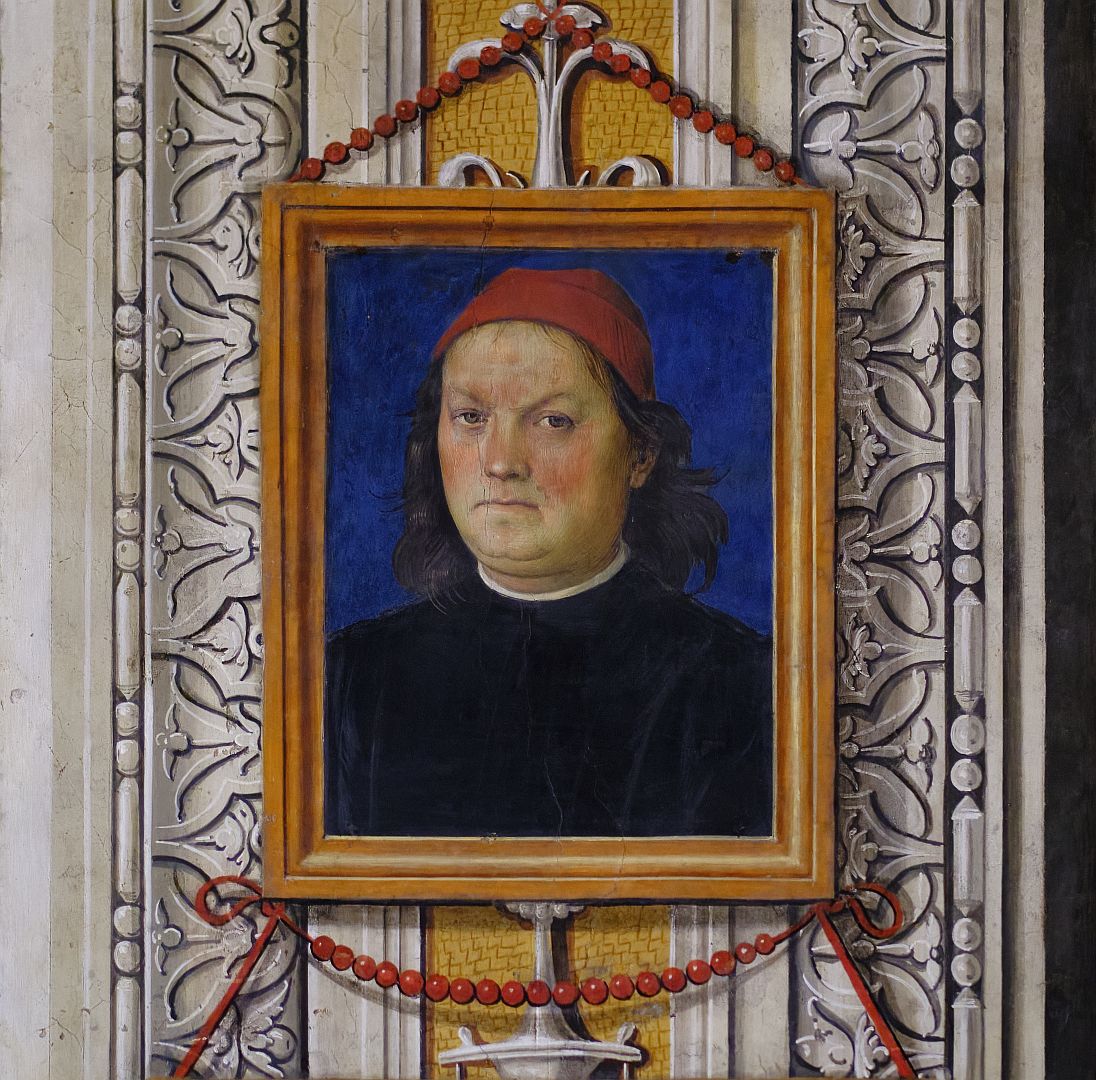
The ancestral lordship of the Baglioni family included the pretty town of Spello, a bit further south from Perugia along the Central Umbrian Valley, between Assisi and Foligno. The old town spills down the hill towards the valley floor in a most picturesque way, and you get a delightful view of it to the left as you head down the SS75 towards Spoleto. It has nice restaurants and bars, some with excellent views of the gap in the mountains through which our old friend the Via Flaminia heads northeast.
One of the most remarkable places to visit in Spello is the Baglioni Chapel in the Collegiate Church of Santa Maria Maggiore. The church was damaged in the 2016 earthquakes and only reopened in late 2019 – even then you had to pick your way through scaffolding to get to the chapel.
The chapel is decorated with frescoes by another painter of the Umbrian school – Pinturicchio, both a contemporary and student of Perugino. Naturally, that’s not his real name. He was born Bernardino di Betto, but was called Pinturicchio (“little painter”) because he was short, and he was a painter. Those names are so inventive, it beats me how they came up with them. But since he signed a couple of works with that name he was presumably at least resigned to it. He did quite a bit of work in Rome, and probably his most famous work is in the Piccolomini Library in the duomo of Siena.
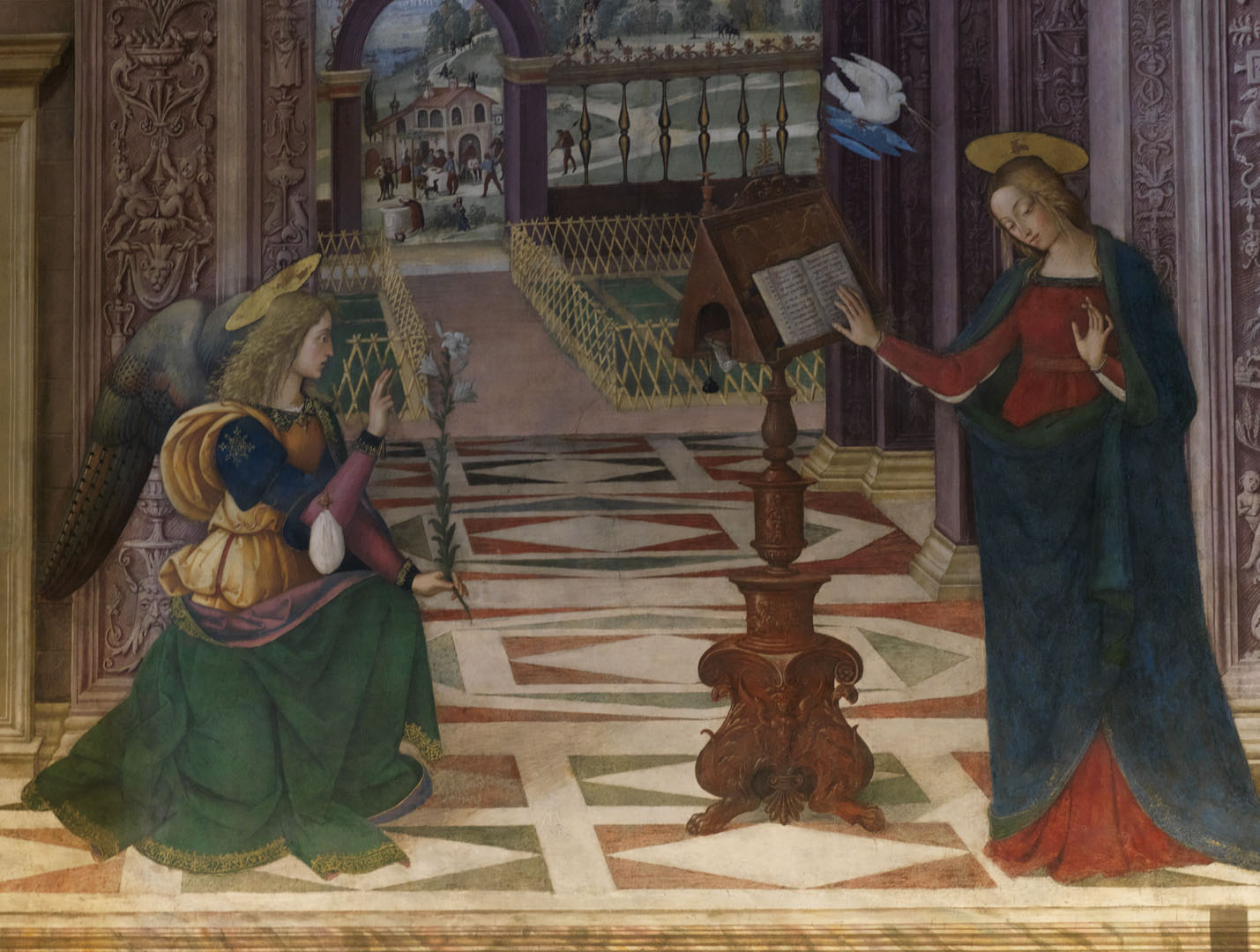
There are three superb frescoes by Pinturicchio in the chapel – an Annunciation, an Adoration of the Shepherds (with the Three Kings queueing up to wait their turn in the background) and a Christ at the Temple.
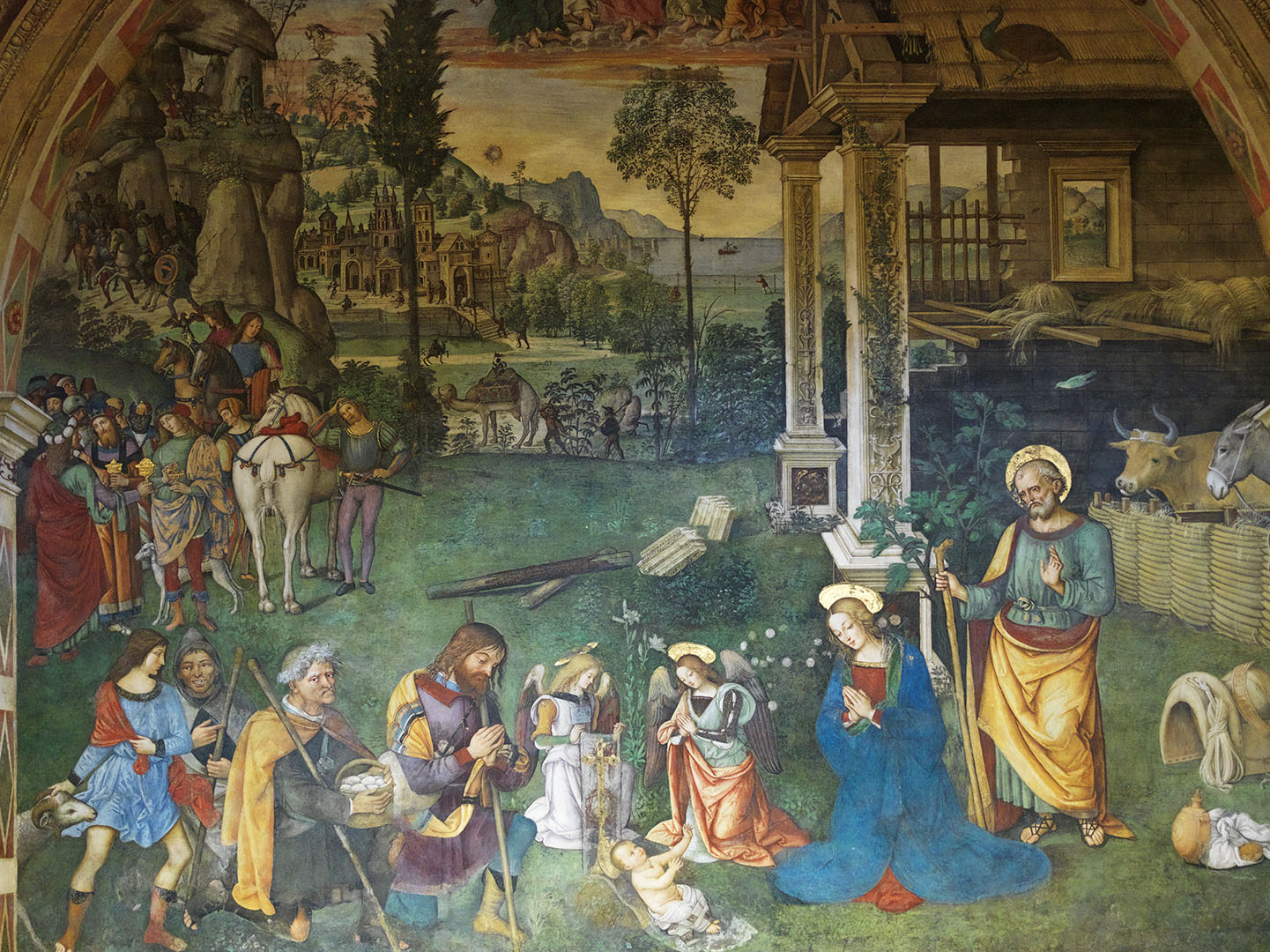
Off to one side in the Annunciation, Pinturicchio has included a framed self-portrait hanging on the wall of Mary’s cloister.

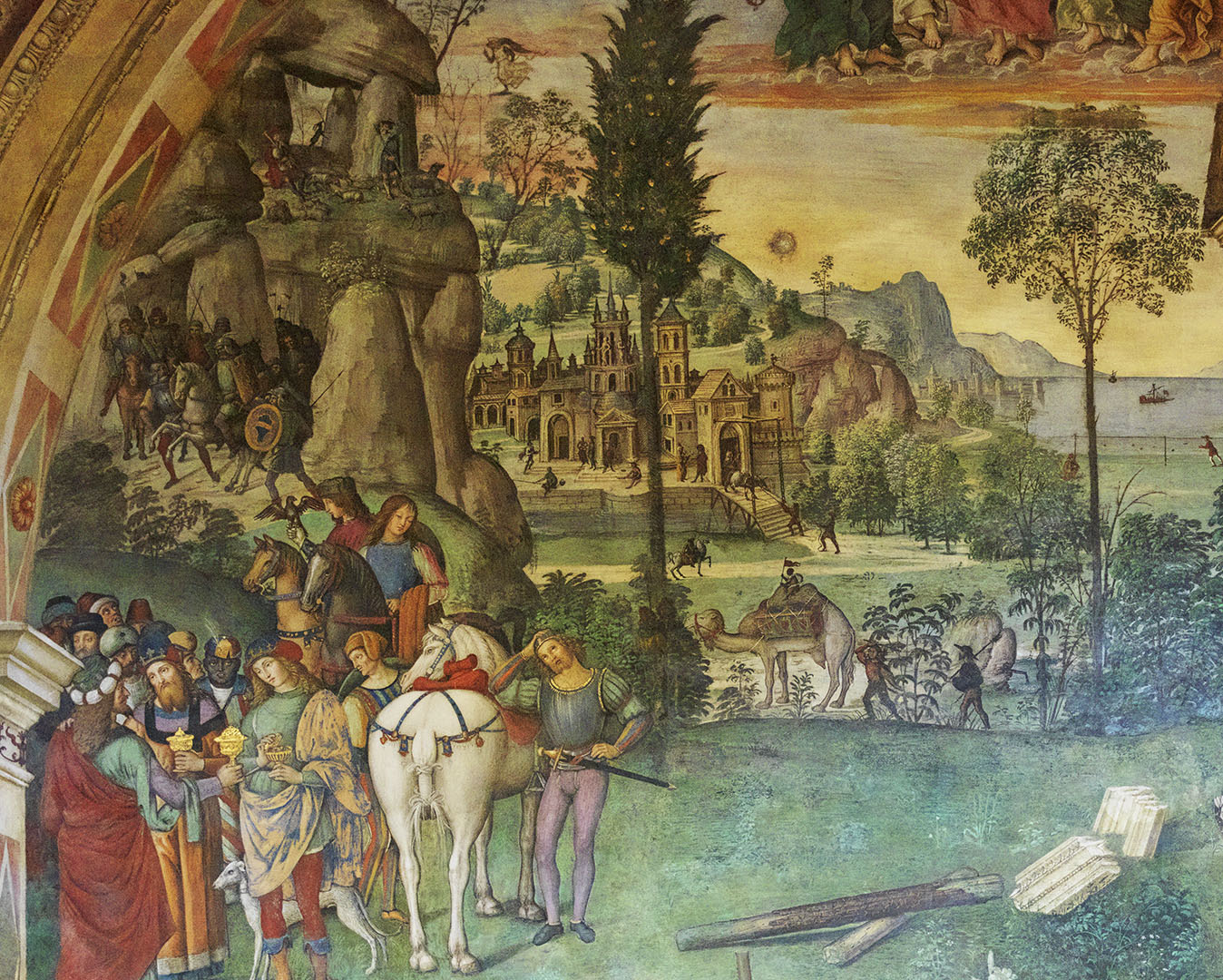
The chapel was commissioned by the local bishop, Troilo Baglioni of that ilk. I have seen a reference to the commission supposedly having been to commemorate the end of the period of conflict within the family which featured the gran tradimento, and the dates would certainly fit. And there are features of the frescoes which further support the hypothesis – if you look past the beauties of the main subjects, in the background there is a Renaissance Italian countryside ravaged by war. Bands of armed men wander the countryside. On a distant hilltop a corpse hangs from a gibbet. It is beautiful, but there is a slightly nightmarish quality to it as well.
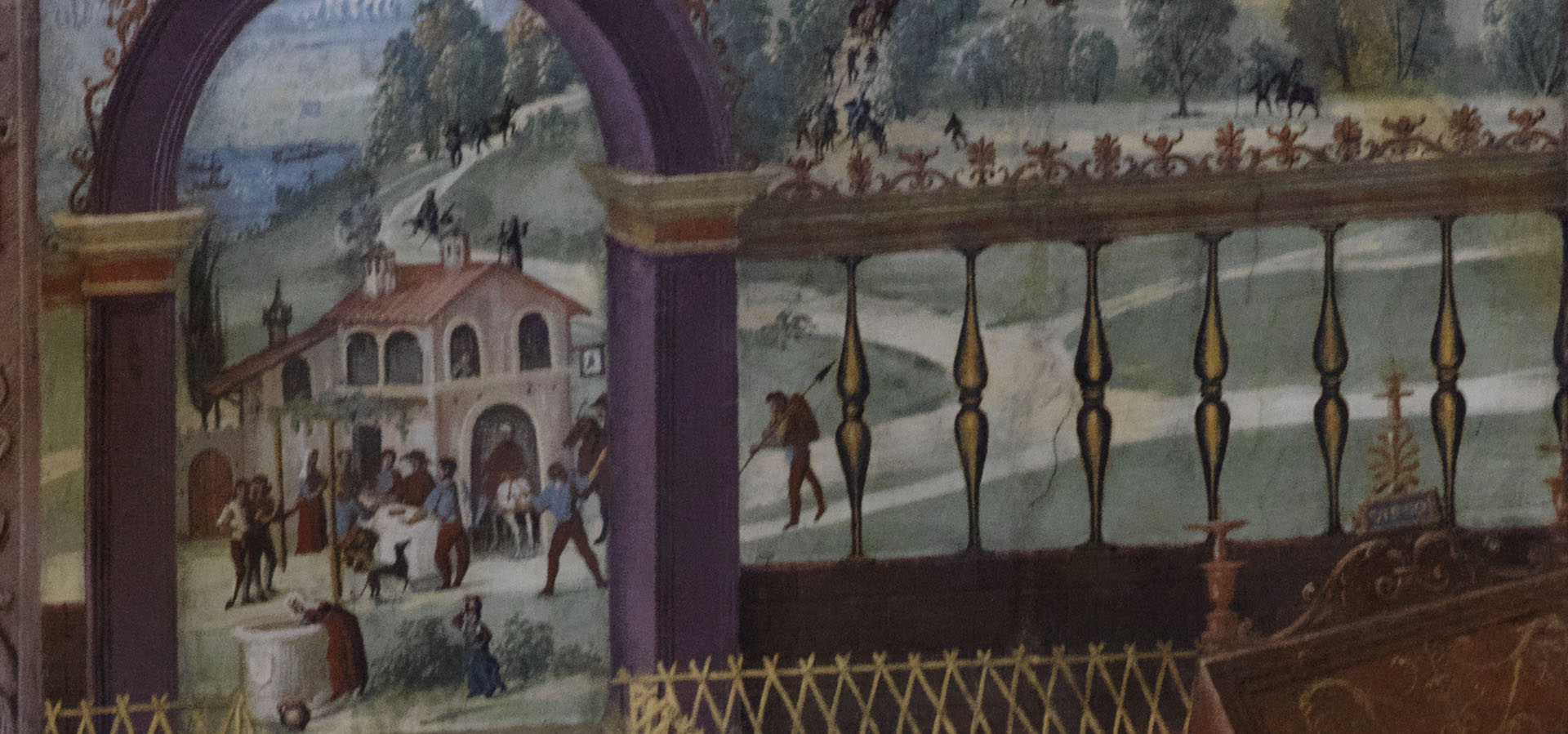
Many of the characters playing bit parts – shepherds, kings and the like – are depicted with such individuality that it seems almost certain that they are portraits of real people. And among the crowd observing Christ at the Temple, we find Troilo Baglioni himself. He may have been a churchman, but he was also a Baglioni, and in an age when bishops, cardinals and even popes led armies and despatched assassins (let’s face it, the Pope at the time was Alexander VI Borgia) Troilo looks like someone who could take care of himself.
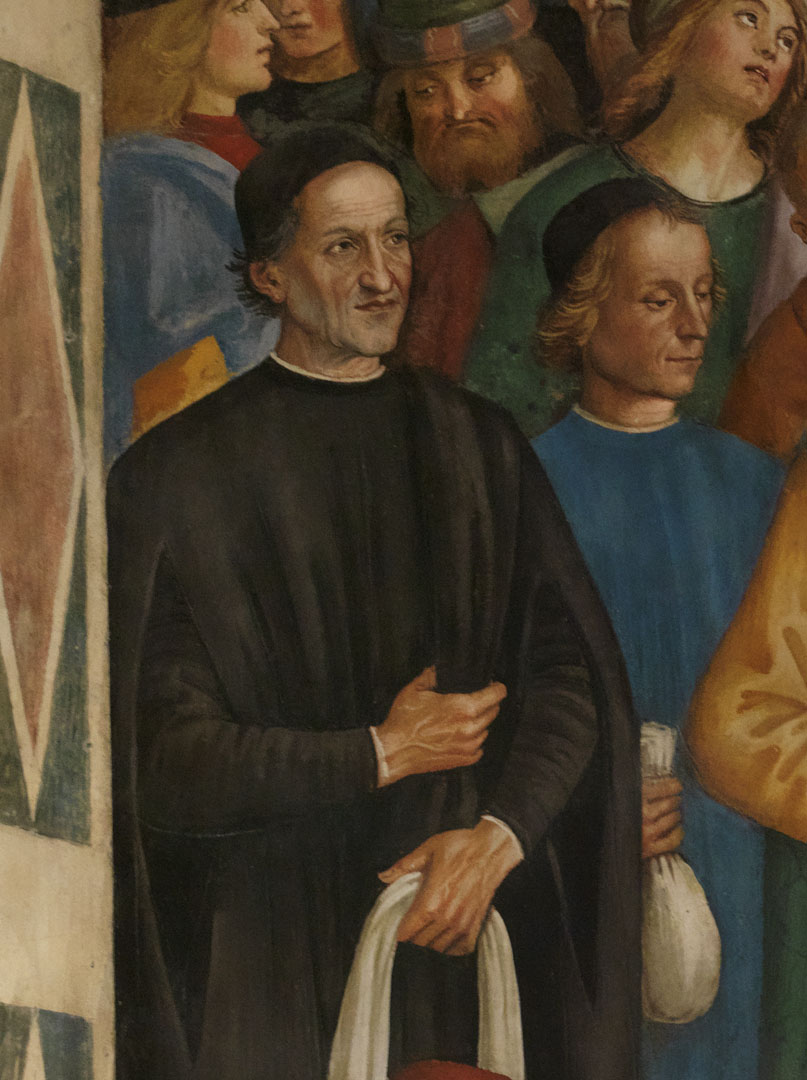
Eventually the Baglioni fought each other to exhaustion, and in 1535 the Papacy saw its chance and took Perugia by force, beginning a period of severe authoritarian rule, and three hundred years of intellectual, economic and artistic impoverishment. There are other interesting stories to tell about Perugia, and more photographs to show, so this will not be my last post on the subject. (Note: it wasn’t. “The Buried Streets of Perugia” was added in June 2022.)
But standing before the Pinturicchio frescoes in the Baglioni Chapel in Spello (and the Perugino in the gallery in Perugia) is a many-layered experience. You are looking at art of great beauty and undoubted piety. But it also depicts real people who were players in desperate and violent personal and political dramas, and the landscapes in which they fought. And it was painted by people who were there at the time. And you are standing where they stood.
Note: in June 2024 we revisited the Baglioni Chapel, to find that the church management has imposed a ban on photography, probably related to the fact that there is now a souvenir shop next door. In any case, I feel I should point out that the photographs included here were taken before any restrictions were imposed.

Thank you. I enjoyed reading this piece and seeing the accompanying art.
It will be good when you can be reunited with your reference books.
Please keep up the posts.